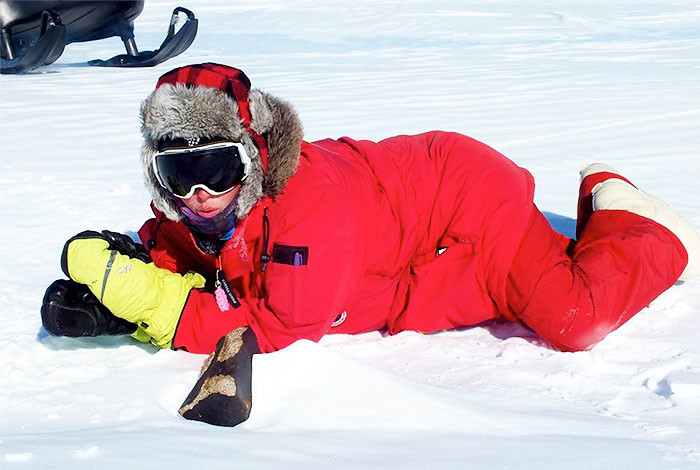The STEM Path to Antarctica

Nina Lanza, a staff scientist on the ChemCam instrument team for the Curiosity Mars Rover, spent two months on the frozen glaciers with the Antarctica Search for Meteorites (ANSMET) program.
The road to a career in a science, technology, engineering, or math (STEM) field is often circuitous—a path that often begins with just a dream. Nina Lanza, a staff scientist on the ChemCam instrument team for the Curiosity Mars Rover, was one of those dreamers who is now living her dream of working as a space scientist, and her curiosity was sparked after attending a STEM-related outreach event.
“In 1986 my parents took me to a public outreach event because Halley’s Comet was going to be visible. I just remember looking through the telescope and realizing that there was something in the sky, that it wasn’t just a flat dome! I wanted to know more, and that’s when I started getting really excited about space. I was seven. Ever since then, I knew I wanted to work in space science. I had no idea how I would do that, but I have been heading in that direction ever since,” said Lanza.
In November, Lanza, who works for the Laboratory’s Space and Remote Sensing group, was selected as one of eight members for the 2015–2016 field campaign of the Antarctica Search for Meteorites (ANSMET) program, which is supported by NASA. The ANSMET program’s mission is to find and collect meteorites in Antarctica—the premier location for finding them because they are spotted more easily against the backdrop of the Antarctic ice. Lanza recently returned from a two-month ANSMET meteorite-hunting excursion and said that life in Antarctica is very similar to living on another planet.
“The ice looks like blue glass. It is incredibly hard. No wildlife, no plants, no infrastructure. I would remind myself that so few people ever get the opportunity to experience this beautiful, rugged, wild, world,” said Lanza. “Physically it was not that hard. I grew up in Boston, so the snow was not a problem. It was cold, but we had the right gear. But the mental challenges were much harder. You leave your support network of your home and family, and you have to find ways to cope with that.”
This was the 39th year of the ANSMET program. Lanza, who resides in Los Alamos, was one of a team of four women and four men who lived on Antarctic glaciers for five weeks. This year’s ANSMET team was somewhat unique in that it included so many women. And although the number of women in STEM fields is growing, women are still a minority overall in these career paths. Studies have shown that in the fourth grade, girls are equal to boys in both aptitude and interest in math and science. Lanza credits her curiosity for being able to realize her dream of being a space scientist.
“I was terrible at school, and I had no idea how to do what I’m doing now, but school is not the same as research. That’s what I’m good at—research! Sometimes the skills of doing well in school aren’t the same skill set as research. You have to be creative and curious about things. I am a daydreamer, and that helps with my research,” said Lanza. “When I went to college, I decided to major in astronomy, but now I’m a geologist. I had to start over a few times.”
Lanza also said that being a woman on the team wasn’t a disadvantage in any way. “What was so great about this project is that if you needed help on something, someone was there to help you, but they didn’t assume that you couldn’t handle the work just because you were female. There was a lot of physical work involved; for example, I had to learn to change the sparkplugs on my snowmobile. They taught me how to do that, and no one expected that I couldn’t do it. It challenged me in ways that I couldn’t have imagined.”
Lanza completed her undergraduate degree in Astronomy at Smith College, an all-women's college in Massachusetts. She went on to complete her Masters in Earth and Environmental Science at Wesleyan University in Connecticut, after which she completed her PhD in Earth and Planetary Science at the University of New Mexico.
Community Connections features news and opportunities that grow out of the Laboratory’s Good Neighbor Pledge: “To partner with our neighbors on strengthening math and science learning, diversifying the economy and expanding community giving in northern New Mexico.”






